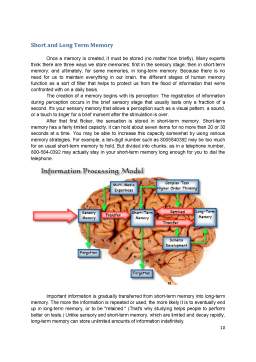Cuprins
- Introduction and short history 3
- Types of memory 5
- Memory Encoding 7
- Memory Retrieval 8
- Short and Long Term Memory 9
- How long-term memory works 11
- Long-term memory and sleep 13
- Long-term memory experiments 14
- Conclusions 16
Extras din proiect
Introduction and short history
Long-term memory (LTM) is memory in which associations among items are stored, as part of the theory of a dual-store memory model. The division of long term and short term memory has been supported by several double dissociation experiments. According to the theory, long-term memory differs structurally and functionally from sensory memory, working memory, short-term memory, and intermediate-term memory. While short-term and working memories persist for only about 20 to 30 seconds, information can remain in intermediate-term memory for 5 to 8 hours, and in long-term memory indefinitely. This differs from the theory of the single-store retrieved context model that has no differentiation between short-term and long-term memory. Long term memory is an important aspect of cognition. Long-term memory can be divided into three processes: encoding, storage, and retrieval. Long-term memory encodes information semantically for storage and the encoding of long-term memory occurs in the medial temporal lobe (and damage to the medial temporal lobe is known to cause anterograde amnesia). In vision, the information needs to enter working memory before it can be stored into long-term memory. This is evidenced by the fact that the speed with which information is stored into long-term memory is determined by the amount of information that can be fit, at each step, into visual working memory.
George Armitage Miller (one of the founders of the cognitive psychology field) considered that while short-term memory is limited to a certain number of chunks of information, long-term memory has a limitless store.
According to the Atkinson–Shiffrin memory model (also known as the multi-store model, a model of memory that has the advantage of being able to be broken down into sub-models of memory: the multi-memory model and the modal model), a dual-store memory model set forth by Atkinson and Shiffrin in 1968, memories can reside in the short-term “buffer” for a limited time while they are simultaneously strengthening their associations in long-term memory. When items are first presented, they enter short-term memory, but because it has limited space, as new items enter, old ones leave. However, each time an item is rehearsed while it is in short-term memory, it is also increasing its strength in long-term memory. The longer an item stays in short-term memory, the stronger the association becomes in long-term memory. In long-term store, items are recalled through retrieval cues in a two-step process. First, context is used as a cue to probabilistically select an item to be potentially recalled. Second, that item is probabilistically determined to be recalled or not.
The transfer of items from short-term to long-term memory is called consolidation. Theories on consolidation are supported by concussion studies. The claim is that concussions completely knock out the working memory as well as the consolidation process, which is critical because if something interrupts this process the subject will have a very poor memory of what happened prior. One study has confirmed this theory.
In 1974 the british psychologist Alan David Baddeley and Professor Graham Hitch proposed an alternative theory to the Atkinson–Shiffrin memory model: Baddeley's model of working memory. According to this theory, short-term memory is divided into different slave systems for different types of input items, and there is an executive control supervising what items enter and exit those systems. The slave systems include the phonological loop, the visuo-spatial sketchpad, and later Baddeley added the episodic buffer.
Biologically, short-term memory is a temporary potentiation of neural connections that can become long-term memory through the process of rehearsal and meaningful association. Not much is known about the underlying biological mechanisms of long-term memory, but the process of long-term potentiation, which involves a physical change in the structure of neurons, has been proposed as the mechanism by which short-term memories move into long-term storage. The time scale involved at each level of memory processing remains under investigation.
As long-term memory is subject to fading in the natural forgetting process, several recalls/retrievals of memory may be needed for long-term memories to last for years, dependent also on the depth of processing. Individual retrievals can take place in increasing intervals in accordance with the principle of spaced repetition. This can happen quite naturally through reflection or deliberate recall (also known as recapitulation), often dependent on the perceived importance of the material.
Long-term memory, unlike short-term memory, is dependent upon the construction of new proteins.This occurs within the cellular body, and concerns in particular transmitters, receptors, and new synapse pathways that reinforce the communicative strength between neurons. The production of new proteins devoted to synapse reinforcement is triggered after the release of certain signaling substances (such as calcium within hippocampal neurons) in the cell. In the case of hippocampal cells, this release is dependent upon the expulsion of magnesium (a binding molecule) that is expelled after significant and repetitive synaptic signaling. The temporary expulsion of magnesium frees NMDA receptors to release calcium in the cell, a signal that leads to gene transcription and the construction of reinforcing proteins
Preview document
Conținut arhivă zip
- The Study of Conceptual or Experimentally Determined Mechanisms that Could Explain the Long-Term Memory Formation
- The study of conceptual or experimentally determined mechanisms that could explain the Long-term memory formation.doc
- The study of conceptual or experimentally determined mechanisms that could explain the Long-term memory formation.pptx




















